|
Report
from
Europe
Confidence in European economy
improves
Prospects for the European economy seem more positive now than this time
last year. The worst fears of a destructive ¡°domino effect¡± that might
have resulted from Greece or another country being forced out of the
euro-zone have failed to materialise.
The effects of the financial crises were largely contained within the
most afflicted economies of southern Europe.
The countries of central and north-western Europe, while experiencing
higher than normal levels of economic volatility, have so far managed to
weather the storm. Their relative stability has prevented the effects of
the financial crises from trickling down throughout Europe.
In recent months, several economic indicators in the EU, such as the
Economic Sentiment Indicator and the Construction Confidence Index, have
improved (see Charts 1 and 2).
There is cautious optimism that economic reforms in the most troubled EU
countries are beginning to work.
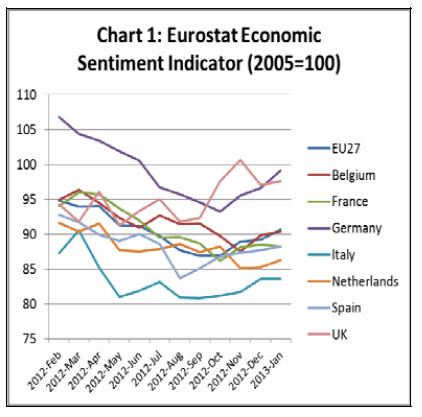
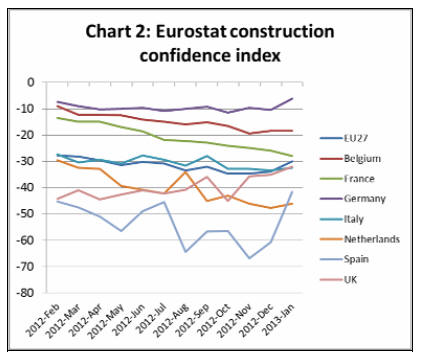
A very long hard road ahead
While confidence has risen, it is starting only from a very depressed
level and remains well below pre-recessionary levels. Many serious
underlying constraints to market growth remain. Financing and credit are
still tight. Companies remain highly risk aversive.
Activity in the construction sector remains very slow and may even
decline further this year. Latest data for the Eurostat Construction
Production Index (Chart 3) and Building Permits Index (Chart 4) have yet
to show any sign that the market has turned a corner.
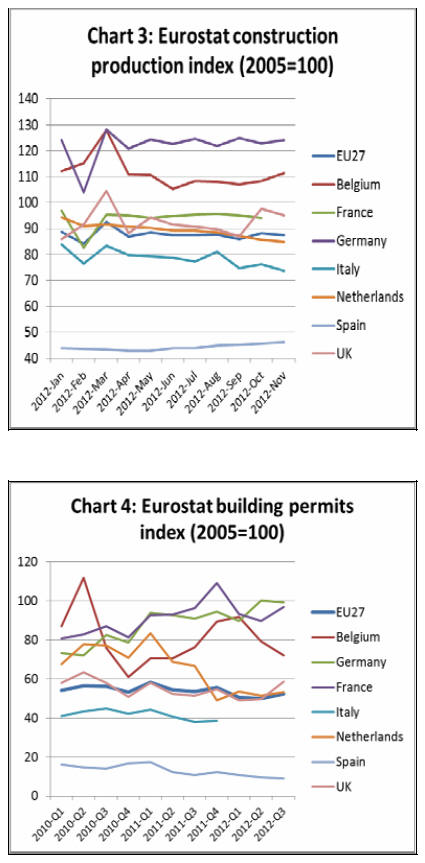
Fourth quarter 2012 GDP data for the large euro-zone economies - France,
Germany, Italy, and Spain - has yet to be published, but economists are
already pencilling in likely declines across the board. After a bouyant
3rd quarter of 2012, the UK economy shrank again (by 0.1%) in the last
quarter of the year.
Mario Draghi, president of the European Central Bank, was gloomy in his
comments to the media on 7 February, suggesting that economic risk
remains skewed to the downside and that there is likely to be further
weakness in 2013.
Reports suggest EUTR already driving changes in EU trade
Already reports are emerging of significant changes in the EU wood
import trade with China as a result of the EU Timber Regulation (EUTR).
The legislation will be enforced from 3 March 2013.
Most reports relate to plywood which is widely expected to be targeted
by environmental groups hoping to raise awareness of EUTR by encouraging
an early prosecution case.
EUTR makes importers personally liable and subject to potentially severe
sanctions if they are found to be handling wood from an illegal source.
They are also liable if they fail to demonstrate implementation of a
"due diligence system" in line with requirements set out in the
regulation. EU government authorities have generally been slow to build
up capacity to enforce the law. However many importers are already
taking action to ensure legal compliance.
This is due as much to the fear of the negative publicity and business
disruption surrounding a prosecution case as it is to the legal
sanctions.
At the end of 2012, there were reports of some EU plywood importers
taking early action to build up landed stocks of sensitive products,
notably uncertified plywood manufactured in China, in advance of the 3rd
March 2013 deadline.
The aim was to ensure they had sufficient material on the ground in
Europe to give breathing space for introduction of the due diligence
systems. As these systems are now being implemented, and any new orders
will arrive after the 3 March deadline, European importers are now being
much more selective in the plywood products being bought from China.
Poplar/bintangor plywood and mixed light hardwood plywood with bintangor,
red canarium, red pencil cedar or similar types of wood are mainly
affected. European importers are concerned that the legal origin of
these wood types cannot be documented with sufficient certainty.
Some importers are also not ordering birch plywood and softwood plywood
with Russian spruce veneers made in China. This is due to concern that
procedures for verifying the legality of Russian logs imported into
China are inadequate and may be influenced by corruption.
EUTR likely to encourage consolidation in EU timber trade
Another potentially significant impact of EUTR is to encourage
increasing consolidation of the international wood products trade.
Representatives of some large European wood importers report that they
are already seeing an upturn in business as many smaller importers are
being discouraged by the risks associated with direct imports from
outside the EU.
EUTR controls and sanctions only apply to the company that ¡°first
places¡± wood on the EU market. This is leading to a situation whereby
larger European companies with the resources and large networks required
for effective due diligence of supply chains outside the EU are offering
this as an extra service to European customers.
Although it is too early to tell for sure, one possible result of EUTR
is that many smaller companies will stop importing direct from outside
the EU. Instead they will only purchase timber products already placed
on the market by larger importers.
Meanwhile EUTR is also expected to encourage greater consolidation
amongst overseas suppliers into the EU. There are already reports of
European importers concentrating their purchases of wood products
amongst a more limited range of overseas suppliers.
Purchases are focused more on those companies best able to provide
credible evidence of legality - ideally through independent systems of
certification or legality verification. There is also concern to
simplify and increase transparency of overseas supply chains.
These trends tend to benefit larger companies with more
vertically-integrated supply chains and that have capital for investment
in due diligence and certification.
EU buying is also more likely to be concentrated on those overseas
suppliers that own or manage their own forest concessions rather than
those that source through third party trading companies.
Europe¡¯s role in the international furniture sector
The EU¡¯s furniture sector remains a major global player, not just due to
its size but also because of its role to influence international fashion
and design trends. The EU accounts for around one quarter of world
furniture production and consumption.
However, the EU¡¯s role in the global furniture market has changed
dramatically during the last decade, particularly during the financial
crises in western countries.
In 2011, EU production of wood furniture was valued at €36 billion, down
from €42 billion in 2007 (Chart 5). The EU has moved from the first to
the second position (after China) amongst the world¡¯s major producing
areas.
While furniture manufacturing in Eastern Europe has risen during the
last decade, particularly in Poland, the traditional western European
manufacturing countries still retain a very large share of EU furniture
production capacity.
In fact, the two largest western European producers, Italy and Germany,
together account for over 40% of all wood furniture supplied into the EU,
and this share was actually rising during the five year period between
2007 to 2011 (Charts 5 and 7).
Despite widespread reports of declining consumption and intense
competition during those years, the value of wood furniture production
in the leading western European manufacturing countries remained very
resilient.
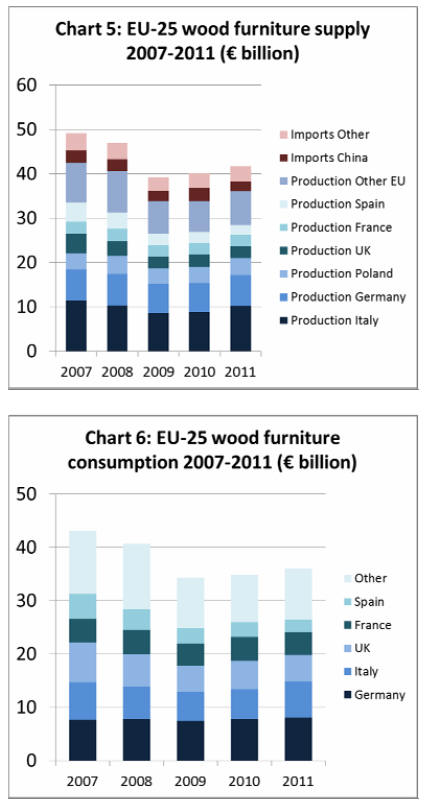
In addition to being major producers, European countries remain major
consumers of furniture products despite the recession (Chart 6). EU wood
furniture consumption fell from €43.2 billion to €34.4 billion between
2007 and 2009. Consumption then recovered slowly to 36.1 billion in
2011.
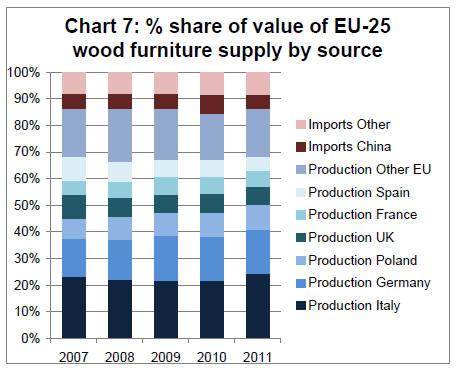
The recovery was particularly robust in Germany, now the EU¡¯s largest
market. Germany consumed €8.1 billion of wood furniture in 2011, up from
€7.4 billion in 2009.
There was also strong recovery in Italy, the EU¡¯s second largest market
for wood furniture.
Italian wood furniture consumption increased from €5.5 billion in 2009
to €6.8 billion in 2011. In the UK and France wood furniture consumption
was quite stable between 2009 and 2011 at around €5 billion and €4.4
billion respectively.
However consumption in Spain continued to fall during this period from
€2.9 billion in 2009 to €2.4 billion in 2011.
Domestic manufacturers continue to dominate European market
While the EU¡¯s presence on the global furniture market has declined in
recent years, European manufacturers have remained very dominant in
their domestic markets. The share of imports in total EU wood furniture
supply peaked at only 16% in 2010 before falling away again to 13% in
2011.
This is in contrast to the United States, for example, where a very
large section of the furniture manufacturing industry shifted to lower
cost locations, particularly China, during the 2000 to 2008 period.
The continuing dominance of local manufacturers in the European market
might seem surprising given relatively high labour and other costs of
production in Europe. There a number of reasons for this. One factor is
the high level of investment in machinery and product development in the
European furniture sector.
This has reduced the relative contribution of labour to overall costs,
and placed a premium on technical, design and market knowledge.
It has boosted the general quality of European products and perceived
value of European brands. European manufacturers have built on this
through sophisticated marketing and communication campaigns.
This in turn has encouraged high levels of loyalty to European products
amongst consumers.
European manufacturers have also exploited other advantages of proximity
to the consumer.
Increasingly important factors in wood furniture marketing include the
ability to supply quickly on demand, respond rapidly to changing tastes,
and to provide customers with support services ¨C including
¡°no-questions-asked¡± guarantees for customers wanting to return
products.
In many European countries, the retailing sector is quite fragmented
with many smaller companies. Selling into these countries requires local
knowledge and a large network of contacts.
It is no accident that the UK, where the retailing sector is more
dominated by large companies, is also the European country with the
largest market penetration by Chinese and other Asian suppliers.
For all these reasons, European manufacturers choosing to relocate
during the last decade have tended to opt for countries in Eastern
Europe which offer a good compromise between lower costs of production
and continued proximity to the large consuming markets of Western
Europe. German manufacturers have tended to shift to Poland, while many
Italian manufacturers opted for Slovenia.
The IKEA factor
It¡¯s not possible to discuss the distribution of wood furniture
manufacturing in Europe without reference to IKEA. The Swedish-based
corporate giant operates a network of 332 stores in 38 countries and has
a global annual turnover of $31 billion.
As such, IKEA claims 6.1% share of the entire world furniture market.
Around three quarters of IKEA's sales are in Europe where it is hugely
dominant at the budget end of the market.
While IKEA has been expanding sales operations into other parts of the
world, its manufacturing base remains firmly rooted in Europe. IKEA's
wood furniture manufacturing facilities are operated by the IKEA
subsidiary Swedwood. This company currently manages 49 production units,
all but two of which are in Europe (the others being in Russia and the
USA).
Swedwood facilities employ around 17,000 people and manufacture
approximately 100 million units of furniture each year. Around two
thirds of Swedwood production is in eastern European countries, with a
high concentration in Poland. Much of the rest of production is located
in Western Europe (Sweden, Germany and Portugal).
Operating under its lean production concept, the Swedwood Way of
Production (SWOP), the organisation has forced down costs by focusing
heavily on efficiency and waste reduction. There is considerable
investment in R&D, both to increase efficiency and product quality.
This is seen as vital to the company's reputation and success. The
business has become a leader in robotic automation of the furniture
manufacturing process. Swedwood also sees it as vital to be located
close to its market in order to respond to local demands.
Until the onset of recession, Swedwood was very actively increasing
production activity close to large consuming markets in Europe and North
America. In 2008 it opened five new state-of-the-art factories in
Sweden, Poland, Russia, the US and Portugal.
Since then the company has temporarily suspended its plans to increase
capacity. However its¡¯ long term strategy, once demand begins to pick
up, is to further expand manufacturing in Europe and other large
consuming markets.
China¡¯s position in the EU furniture market
EU imports of wood furniture from China have been very volatile in
recent years (Chart 8). Imports fell sharply at the height of the
financial crises, from €2.8 billion in 2008 to only €2.3 billion in
2009. However they then rebounded strongly to reach a peak of €3 billion
in 2010.
However, this import level seriously over-shot actual consumption and
imports fell back again to €2.6 billion in 2011. In 2011, upholstered
seating was the main wood furniture product imported into the EU from
China, accounting for 34% of import value. Of the remainder, 20% was
dining/living room furniture, 12% was bedroom furniture, 6% was
non-upholstered seating and 28% other product categories.
China¡¯s share in total EU wood furniture consumption peaked in 2010, at
8%, before falling away to 6% in 2011 (Chart 9). China¡¯s penetration of
the market varies widely between EU Member States, from 16% in the UK to
less than 2% in Italy.
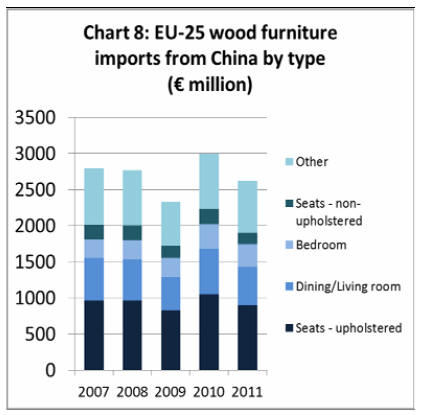
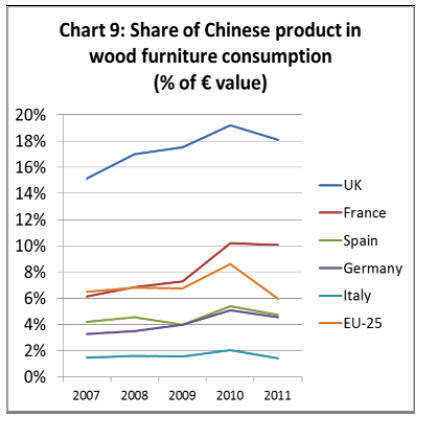
Recent trends and outlook for the European furniture market
The most recent Eurostat data indicates that wood furniture production
across the EU region was only around 83% of pre-recession levels during
2012 and still trending downwards (Chart 10).
Furniture production during the first nine months of 2012 in Italy,
Poland, the UK, France and Spain was significantly lower than during the
same period the previous year. However production in Germany during 2012
was higher than in 2011.

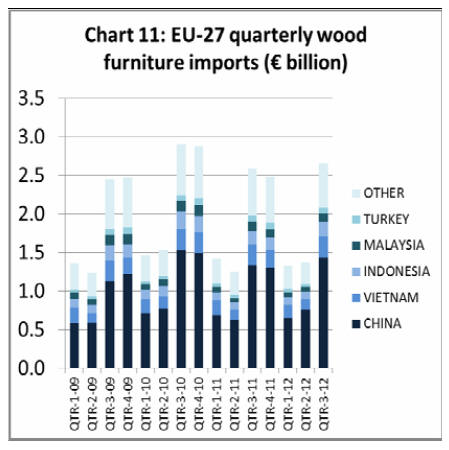
Trends in EU wood furniture imports during 2012 are more difficult to
assess due to the highly seasonal nature of trade and lack of published
data for the last quarter of the year ¨C when a large proportion of
product is imported in time for Christmas and the January sales period
(Chart 11).
However, quarterly data to end September 2012 suggests that imports last
year were very similar to 2011 but still well down on the 2010 peak.
One potentially significant trend is a gradual but consistent increase
in the share of total EU wood furniture import value derived from China
from 46% in the 3rd quarter of 2009 to 54% in the same quarter of 2012.
Much of China¡¯s increase in share has been at the expense of South East
Asian countries, including Vietnam, Indonesia and Malaysia.
Forecasts for the European furniture industry issued by the research
organisation CSIL in December 2012 are quite cautious. CSIL suggest the
value of European furniture consumption fell by -1% in 2012 and is
likely to remain stable at this lower level in 2013.
CSIL forecast that over the next 12 months, demand will be slightly
stronger in the Scandinavian countries, stable in the UK and Central
Europe, but will weaken further in southern European countries.
* The market information above has been generously provided by the
Chinese Forest Products Index Mechanism (FPI).
|